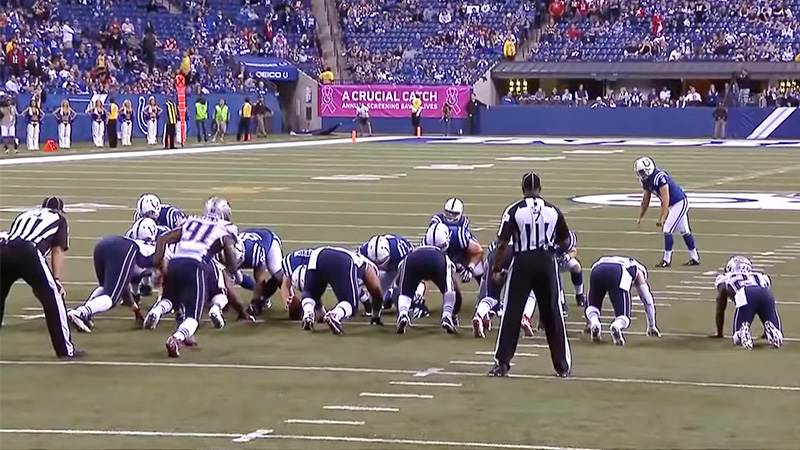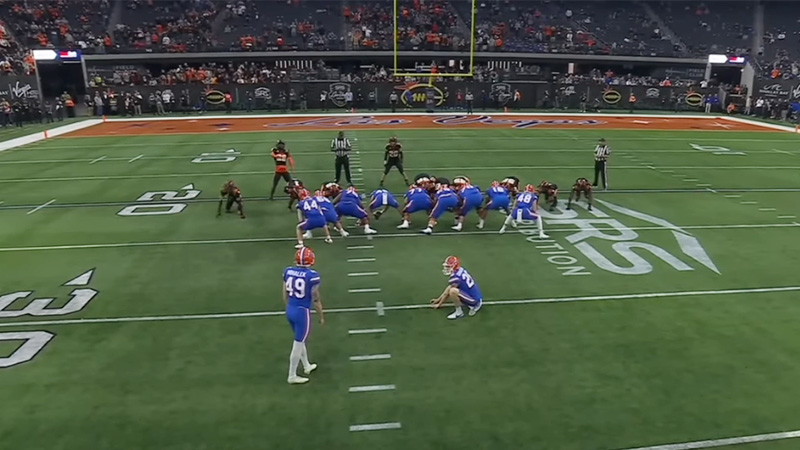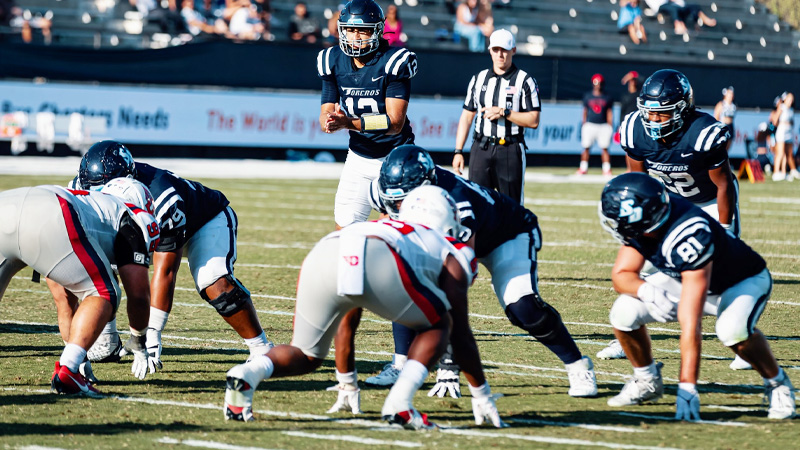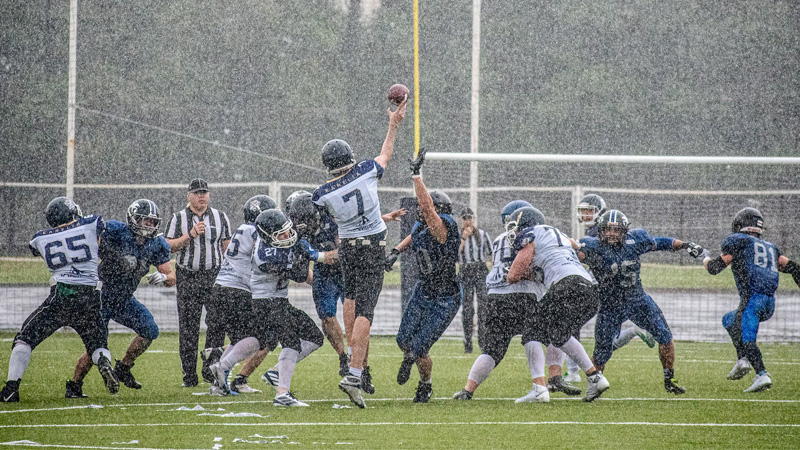In the dynamic realm of American football, a single play has the potential to redefine the course of a game the blocked field goal return.
This strategic defensive move involves not only thwarting the opponent’s scoring attempt but seizing the opportunity to turn defense into offense.
The question arises: How many points does a team earn when a blocked field goal is not just denied but transformed into a triumphant sprint toward the end zone?
Understanding the scoring intricacies of this electrifying play adds depth to the excitement of football.
In this exploration, we unravel the points system governing blocked field goal returns, shedding light on the pivotal moments when a defensive stance becomes a touchdown celebration.
What Is A Blocked Field Goal Return In Football?
A blocked field goal return in American football occurs when a defensive player successfully blocks an attempted field goal by the opposing team and then picks up the ball and returns it toward the opposing end zone.
Here’s a breakdown of the key components:
Blocked Field Goal
When a team is attempting a field goal, the defensive players will try to block the kick by jumping and reaching their hands or arms toward the trajectory of the ball.
If a defensive player successfully deflects or blocks the ball, it is considered a blocked field goal.
Return
After the field goal attempt is blocked, the ball is live and can be picked up by any player on either team.
If a defensive player grabs the blocked ball, they can attempt to advance it by running toward the opposing team’s end zone.
Potential Scoring
If the player who recovers the blocked field goal manages to return it all the way to the opposing end zone, it results in a touchdown for the defensive team.
This is a rare but exciting play that can have a significant impact on the outcome of a game.
A blocked field goal return for a touchdown is a particularly dramatic and momentum-shifting play, as it often involves a combination of skill, timing, and athleticism by the defensive player or players involved.
It’s worth noting that the rules regarding blocked field goals and subsequent returns may vary slightly depending on the level of play (e.g., high school, college, professional) and any specific rule modifications in use.
How Many Points Is A Blocked Field Goal Return In Football?
In American football, a touchdown resulting from a blocked field goal return is worth six points.
If a defensive player blocks a field goal attempt and then returns the blocked kick all the way to the opposing team’s end zone, it is considered a touchdown, and the scoring team is awarded six points.
After a blocked field goal return for a touchdown, the scoring team typically has the option to attempt an extra point kick or a two-point conversion, depending on their strategic preference.
It’s worth noting that a touchdown resulting from a blocked field goal return is a relatively rare and exciting play, often requiring a combination of skill, timing, and athleticism by the defensive player or players involved.
How The Points Are Counted for A Blocked Field Goal Return?

The points awarded for a blocked field goal return in American football depend on the outcome of the play.
Here’s how the points are counted:
Blocked Field Goal
When a field goal attempt is blocked, the ball becomes live, and any player from either team can recover it.
No Touchdown on Return
If the defense recovers the blocked field goal attempt but does not return it for a touchdown, the team gets no additional points. The defense, however, gains possession of the ball at the spot where the ball was recovered.
Touchdown on Return
If the defensive player who recovers the blocked field goal successfully advances the ball all the way to the opposing end zone, it is considered a touchdown. In this case, the defensive team is awarded six points.
Potential for Extra Points
After scoring a touchdown on a blocked field goal return, the defensive team has the option to attempt an extra point kick or a two-point conversion.
An extra-point kick is worth one point, while a two-point conversion, which involves running or passing the ball into the end zone from a specified distance, is worth two points.
No Points for the Blocked Field Goal Alone
It’s important to note that the act of blocking the field goal itself doesn’t result in points. Points are only awarded if the defense successfully recovers the blocked kick and returns it for a touchdown.
The points awarded for a blocked field goal return are contingent on whether the defensive team can advance the ball all the way to the opposing end zone for a touchdown.
If successful, the team is awarded six points, and they then have the opportunity to score additional points through an extra point kick or a two-point conversion.
The Basics of a Field Goal

A field goal is a method of scoring in American football that involves kicking the ball through the goalposts located at the back of the end zone.
Here are the basics of a field goal in American football:
Scoring
A successful field goal is worth three points. The team attempting the field goal aims to kick the ball through the uprights and over the crossbar of the goalposts.
Attempt
Field goal attempts usually occur on fourth down when a team is within a reasonable distance from the goalposts but doesn’t want to risk a turnover on downs.
However, teams may attempt field goals at other times if they believe it’s a strategic move.
Snap and Hold
Like extra point attempts and punts, a field goal attempt starts with a snap from the center to the holder.
The holder places the ball on the ground, holds it in position, and the kicker then attempts to kick it through the goalposts.
Distance
The distance of a field goal attempt is measured from the line of scrimmage to the goalposts. The further away the line of scrimmage is from the goalposts, the more challenging the field goal attempt becomes.
Hash Marks
The hash marks on the field indicate the location of the ball. The kicker can choose to position the ball on the hash marks to the left or right of the field, depending on their and the team’s preference.
Goalposts
The goalposts are located at the back of the end zone. They consist of two uprights and a crossbar. The uprights are positioned 18 feet, 6 inches apart. The crossbar is 10 feet above the ground.
Blocking
The defensive team will often try to block a field goal attempt by jumping and reaching toward the ball as it is kicked. If the ball is blocked and does not pass through the goalposts, the field goal is unsuccessful.
Missed Field Goals
If a field goal attempt is missed, the opposing team takes possession of the ball at the spot of the attempt (or at the line of scrimmage if the attempt was from beyond the 20-yard line).
Field goals are a crucial part of scoring in football and are often used when a team is within range but unable to reach the end zone for a touchdown.
The accuracy and leg strength of the kicker plays a significant role in the success of field goal attempts.
Football Rules Regarding the Blocked Field Goal

The rules regarding a blocked field goal in American football are outlined by various organizations, such as the National Football League (NFL) and the NCAA (for college football).
While the basic principles are generally consistent, there might be some nuances and differences between leagues.
Here are the general rules:
Live Ball
When a field goal attempt is blocked, the ball becomes a live ball. This means that any player from either team can recover the ball and advance it.
Line of Scrimmage
If the ball is blocked behind the line of scrimmage and is recovered by the defense, the defense takes possession of the ball at the spot of the recovery.
Beyond the Line of Scrimmage
If the ball is blocked beyond the line of scrimmage and lands in the field of play, it is a live ball.
The defense has the opportunity to recover it and advance, but if they don’t, the offensive team takes possession at the spot where the ball went out of bounds.
Touchdown on Return
If the defense recovers the blocked field goal attempt and returns it for a touchdown, they are awarded six points. This is considered a defensive touchdown.
No Advance Across the Line of Scrimmage
In some leagues, if the blocked kick does not cross the line of scrimmage, the defense cannot advance the ball. The play is dead, and the offense takes over at the spot of the block.
Blocked Extra Point Attempts
Similar rules apply to blocked extra-point attempts. The defense can recover a blocked extra-point attempt and potentially score two points by returning it to the other end zone.
However, if the offense recovers and manages to score (e.g., bypassing or running into the end zone), they are awarded two points.
Penalties
Penalties during a field goal attempt can impact the outcome.
For instance, if the defense commits a penalty that results in a first down for the offense, the penalty may nullify the block, and the offense may retain possession with a new set of downs.
It’s important to note that specific rules can vary between leagues, and rule changes may be implemented over time.
The above points provide a general overview of how the game is typically officiated in relation to blocked field goals, but consulting the rulebook of the specific league or organization in question is advisable for precise details.
FAQs
Can a blocked field goal be returned for points in football?
Yes, if a defensive player blocks a field goal attempt and returns the blocked kick all the way to the opposing end zone, the defensive team is awarded six points for a touchdown.
Are there additional points for blocking a field goal besides preventing the score?
No, the act of blocking a field goal itself doesn’t earn points. Points are only awarded if the defense successfully recovers the blocked kick and returns it for a touchdown.
Can a blocked extra-point attempt also result in points for the defensive team?
Yes, similar to a blocked field goal, a blocked extra point attempt can be returned for a touchdown, earning the defensive team six points.
Afterward, they have the option to attempt an extra point or two-point conversion.
What happens if the blocked field goal doesn’t cross the line of scrimmage?
In some leagues, if the blocked kick doesn’t cross the line of scrimmage, the defense cannot advance the ball.
The play is dead, and the offense takes over at the spot of the block with no points awarded to the defense.
How are additional points scored after a blocked field goal return for a touchdown?
Following a blocked field goal returned for a touchdown, the defensive team has the option to attempt an extra point kick for one point or a two-point conversion for two points.
These points are additional to the six points awarded for the touchdown.
Wrapping Up
The blocked field goal return stands as a testament to the unpredictable and exhilarating nature of football.
Beyond preventing points, it offers a potential six-point boost to the defensive team—a game-changer that can shift momentum and redefine the outcome.
Whether it’s the thrill of the chase or the strategic decisions that follow, the points attached to this play add layers of excitement to the sport.
In the intricate dance of athleticism and strategy, the blocked field goal return emerges as a dynamic element, reminding us that in football, every blocked kick holds the potential to reshape the narrative of the game.







